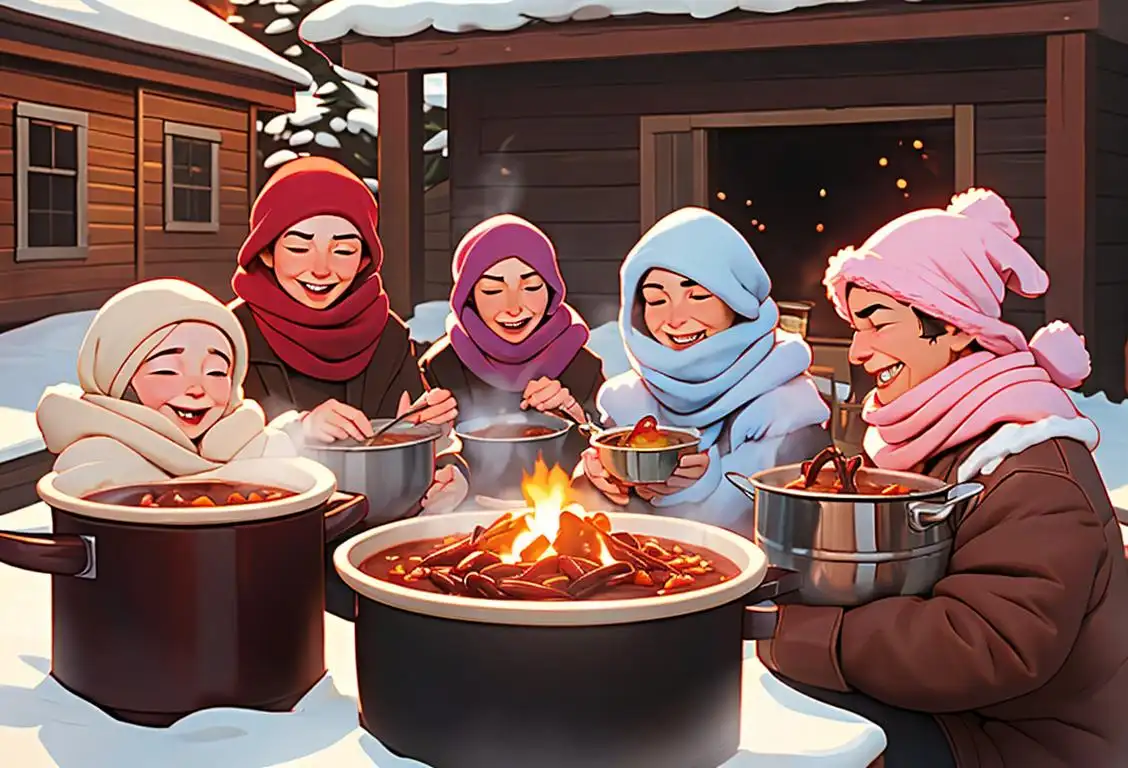National Herbs And Spices Day

Hey there, herbivores and spice lovers! Get ready to add some flavor to your day because it's National Herbs and Spices Day!
When is Herbs And Spices Day?
It's national herbs and spices day on the 10th June.
A Dash of History
Have you ever wondered how herbs and spices became such an integral part of our culinary adventures? Well, let's take a journey through time and explore their origins.
Herbs and spices have been used for thousands of years, dating back to ancient civilizations like Egypt, Greece, and Rome. These aromatic plants were not only valued for their ability to enhance the taste of food but also for their medicinal properties.
During the Middle Ages, spices like cinnamon, ginger, and pepper were highly sought after and considered symbols of wealth. Explorers embarked on perilous journeys in search of these precious commodities, leading to the era of spice trade and the discovery of new lands.
In the age of the internet, we can now easily access a wide range of herbs and spices from all around the world. From the smoky depths of paprika to the zesty kick of cumin, our taste buds are in for a treat!
A Flavorful Celebration
To honor National Herbs and Spices Day, why not embark on a culinary adventure of your own? Try experimenting with different spice blends or whip up a delicious herb-infused dish. Your taste buds will thank you!
Get creative in the kitchen and discover the magical combination of flavors that herbs and spices can bring to a simple meal. Whether you're a newbie chef or a seasoned foodie, this day is all about celebrating the diverse world of herbs and spices.
Did You Know?
In ancient times, herbs and spices were more than just flavor enhancers. They were also believed to possess magical properties. For example, basil was thought to ward off evil spirits, while thyme was believed to bring courage and strength. So the next time you sprinkle some herbs or spices into your cooking, take a moment to appreciate the mystical origins behind these flavorful friends!
History behind the term 'Herbs And Spices'
1000 BCE
Early Use in Ancient Civilizations
The history of herbs and spices can be traced back to around 1000 BCE, where they played a crucial role in the culinary and medicinal practices of ancient civilizations. The early Egyptians, for example, used herbs and spices for embalming purposes and also in their daily cooking. Similarly, in ancient India and China, an array of herbs and spices were utilized for their therapeutic properties and to enhance the flavors of food.
3500 BCE
Early Beginnings
Herbs and spices have been used for thousands of years, with evidence dating back to Ancient Egypt. In the year 3500 BCE, archaeologists have discovered hieroglyphics depicting the harvesting and use of herbs and spices by the Egyptians. These early civilizations recognized the flavor-enhancing properties of herbs and spices, as well as their medicinal applications. They were highly valued and often used as currency for trade.
Ancient Times
Early Use of Herbs and Spices
The history of herbs and spices dates back to ancient times, where they were used for medicinal and culinary purposes. Egyptians were one of the earliest civilizations to cultivate and use spices such as coriander, cumin, and garlic. These early civilizations discovered the unique flavors, aromas, and healing properties of various plants.
3500 BCE
Ancient Mesopotamia: The Birth of Culinary Flavor
The origins of the term 'herbs and spices' can be traced back to ancient Mesopotamia, around 3500 BCE. Mesopotamians were among the first to cultivate herbs and spices, recognizing their value in enhancing the flavor of food. They utilized various plants, such as coriander, cumin, and thyme, to add depth and complexity to their cuisine.
1000 BCE
Indian Influence
During this time, the use of herbs and spices became particularly significant in Indian cuisine. Ancient texts such as the Rigveda (a sacred Indian scripture) mention the importance of various herbs and spices in cooking and religious rituals. Turmeric, ginger, cardamom, and cinnamon were highly prized and considered to have healing properties.
3400 BCE
The Ancient Spice Trade
The ancient spice trade began around 3400 BCE. It was during this time that spice merchants from Mesopotamia and Arabia started to establish trade routes to India and China, seeking valuable herbs and spices. Spices like cinnamon, black pepper, and ginger were highly prized and sought after for their medicinal properties and their ability to enhance the taste of food.
1st Century CE
The Spice Trade Routes
During the 1st century CE, the establishment of the Spice Trade Routes contributed to the spread and popularity of herbs and spices. These trade routes connected different regions, allowing the exchange of exotic spices like cinnamon, cloves, and black pepper. The demand for these valuable commodities led to the exploration and discovery of new lands, prompting the age of exploration.
1550 BCE
Ancient Egypt: Sacred Herbs and Fragrant Spices
In ancient Egypt, around 1550 BCE, herbs and spices took on a vital role not only in culinary practices but also in rituals and medicine. Egyptians were renowned for their use of herbs like garlic, dill, and parsley, while spices such as cinnamon, cumin, and cardamom added delightful aromas and flavors to their food. These ingredients were often seen as sacred and associated with deities and embalming rituals.
1200 - 500 BCE
Herbs and Spices in Ancient Greece and Rome
During the classical period of ancient Greece and Rome, herbs and spices played a crucial role in their culinary traditions and religious practices. The Greeks used herbs like oregano, thyme, and mint in their cooking, while the Romans used a wide variety of spices such as saffron, coriander, and mustard. These civilizations greatly valued the flavors and scents that herbs and spices added to their food.
327 BCE
The Conquest of the Spice Trade: Alexander the Great
In 327 BCE, Alexander the Great's conquests introduced the Western world to a vast array of herbs and spices. As his armies journeyed through Asia, they encountered exotic flavors like ginger, saffron, and turmeric, which were highly valued and brought back to Greece and beyond. This marked a significant turning point in the spread of herbs and spices, as they became sought-after commodities in trade.
500 BCE
Greek and Roman Discoveries
Herbs and spices gained popularity in Greece and Rome during this period. Greek physician Hippocrates, known as the father of medicine, emphasized the use of herbs and spices for their therapeutic benefits. The Romans, influenced by Greek culture, embraced the use of spices such as peppercorn, saffron, and coriander in their cuisine. Their extensive trading networks allowed for the introduction of new spices from distant lands.
Middle Ages
Herbs and Spices as Currency
In the Middle Ages, herbs and spices were highly prized and considered a form of currency. Merchants from Europe, Asia, and the Middle East would travel long distances to trade spices, making it a lucrative business. The value of certain spices, such as saffron and nutmeg, was even equivalent to or sometimes exceeded the value of gold. The trade of herbs and spices greatly influenced the economy and cultural exchange during this period.
500 - 1500 CE
The Age of Exploration and Spice Trade
The period from the 5th to the 15th century was marked by the Age of Exploration, where European explorers set out in search of new trade routes and exotic goods. One of the primary motivations for these voyages was the discovery of new sources of herbs and spices. This era saw the emergence of famed explorers like Christopher Columbus and Vasco da Gama, who played significant roles in expanding the world's knowledge and trade of herbs and spices.
15th-16th Century
Explorations and Colonialism
The 15th and 16th centuries marked the Age of Exploration and the era of European colonialism. European powers, such as Portugal and Spain, sought direct sea routes to Asia to gain control of the lucrative spice trade. They discovered new territories, including the Americas, which led to the introduction of herbs and spices like chili peppers and vanilla to the Western world. This increased availability and diversity of spices transformed European cuisines and enhanced global trade.
14th-16th century
The Age of Exploration: Spices Shape History
During the 14th to 16th centuries, the Age of Exploration saw European nations embark on maritime expeditions in search of direct routes to the spice-rich lands of Asia. The desire for herbs and spices motivated explorers like Christopher Columbus and Vasco da Gama, who ultimately reshaped the course of history. These intrepid voyages brought previously unknown flavors, such as cloves, nutmeg, and black pepper, to Europe, forever altering culinary traditions and igniting a global spice trade.
7th Century
Islamic Contributions
Islamic civilization made significant contributions to the knowledge and use of herbs and spices. Scholars like Ibn Sina (Avicenna) documented the medicinal properties of numerous herbs and spices, providing detailed descriptions and classifications. Arab traders also played a vital role in the distribution of spices to Europe, introducing cinnamon, nutmeg, cloves, and more to the Western world.
19th-20th Century
Industrialization and Mass Production
The industrial revolution in the 19th century brought significant advancements in transportation, storage, and manufacturing processes. This revolutionized the production and distribution of herbs and spices, making them more accessible to the general population. Furthermore, the development of canning and preserved spice products enabled people to enjoy the flavors of herbs and spices regardless of the season. The rise of multinational food companies during the 20th century further popularized the use of herbs and spices in packaged, processed foods.
15th Century
Age of Exploration
The Age of Exploration in the 15th century brought about a renewed interest in herbs and spices. Explorers, most notably Christopher Columbus, embarked on voyages to discover new trade routes to the East. These expeditions aimed to find valuable commodities such as herbs and spices, which were highly sought after in Europe. This era marked the beginning of global spice trade and opened new possibilities for culinary innovation.
18th-19th century
Colonialism and Spice Monopolies
During the 18th and 19th centuries, European colonial powers established trade monopolies in various countries, including India, Indonesia, and Sri Lanka, to control the production and distribution of spices. The British East India Company, for instance, held significant control over the spice trade and played a pivotal role in shaping the world's access to herbs and spices. This period also gave rise to the creation of spice blends, such as curry powder, which emerged as a consequence of colonial influence and fusion of culinary traditions.
1498
Vasco da Gama's Voyage to India
In 1498, Vasco da Gama, a Portuguese explorer, successfully sailed from Europe to India, establishing a direct sea route. This voyage opened up direct access to the rich spice markets of India, allowing Europeans to bypass the spice merchants of the Middle East. This development significantly impacted the European economy and led to increased consumption and popularity of herbs and spices in Western cultures.
17th Century
Colonial Expansion and Global Spice Trade
During the 17th century, European powers such as the Dutch, British, and French expanded their colonial empires across different parts of the world. These powers established lucrative spice plantations and trading posts in regions like India, Indonesia, and the Caribbean. The global spice trade flourished during this time, with vast quantities of herbs and spices being shipped back to Europe, transforming culinary traditions and introducing new flavors to different cultures.
21st century
Herbs and Spices in the Modern World
Today, herbs and spices continue to captivate taste buds and enrich dishes worldwide. They are no longer elusive or reserved for the nobility but are accessible to people from all walks of life. With ongoing globalization, culinary fusion, and growing interest in healthy and flavorful cooking, the appreciation for herbs and spices has reached new heights. From the versatility of oregano and thyme to the piquancy of chili peppers and the intricate blends of garam masala, these botanical wonders remain an integral part of our diverse culinary landscape.
18th-19th Century
Industrial Revolution
The Industrial Revolution transformed the production and accessibility of herbs and spices. With advancements in transportation, preservation techniques, and packaging, the distribution of herbs and spices became more widespread. This led to a surge in their usage in various cuisines around the world. The discovery and cultivation of new herbs and spices became easier, enriching global culinary traditions.
Present Day
Cultural Diversity and Culinary Delights
In the present day, herbs and spices continue to hold a significant cultural impact on cuisines around the world. They are celebrated for their diverse flavors, aromas, and health benefits. Different regions have their unique blends and combinations of herbs and spices, which play an integral role in defining their culinary traditions. Whether it's the curry powders of India, the herbes de Provence in French cuisine, or the complex spice mixtures of the Middle East, herbs and spices add depth and character to dishes enjoyed by people worldwide.
20th Century
Modernization and Fusion
In the 20th century, the globalization of food and travel facilitated the fusion of culinary traditions. Chefs and home cooks began experimenting with various herbs and spices from different cultures, creating unique flavor profiles. Additionally, advancements in agriculture and transportation allowed for the cultivation and importation of herbs and spices on a larger scale, making them more accessible to people worldwide.
Did you know?
Did you know that the world's most expensive spice is saffron? It takes around 75,000 saffron crocus flowers to produce just one pound of this delicate and aromatic spice. No wonder it's considered worth its weight in gold!Tagged
food fun historyFirst identified
10th June 2015Most mentioned on
10th June 2016Total mentions
230Other days
Senior Citizens Day
French Fries Day
Hot Chocolate Day
Lasagna Day
Jelly Bean Day
Chili Day
Nacho Day
Vodka Day
Martini Day
Pastry Day









